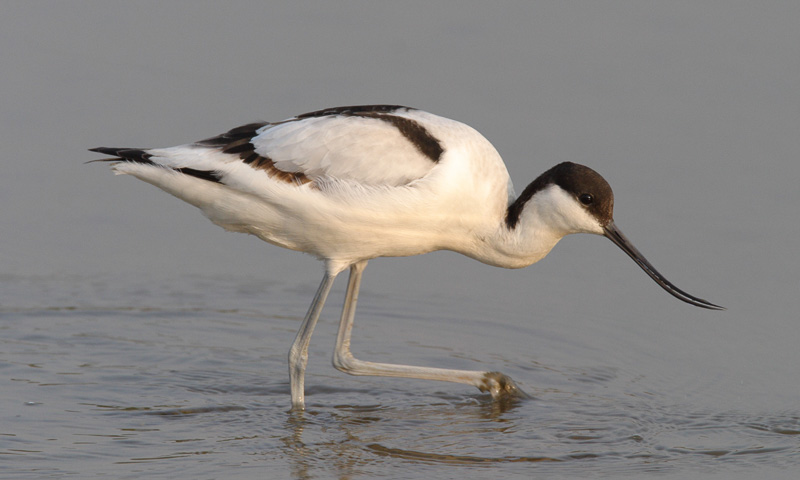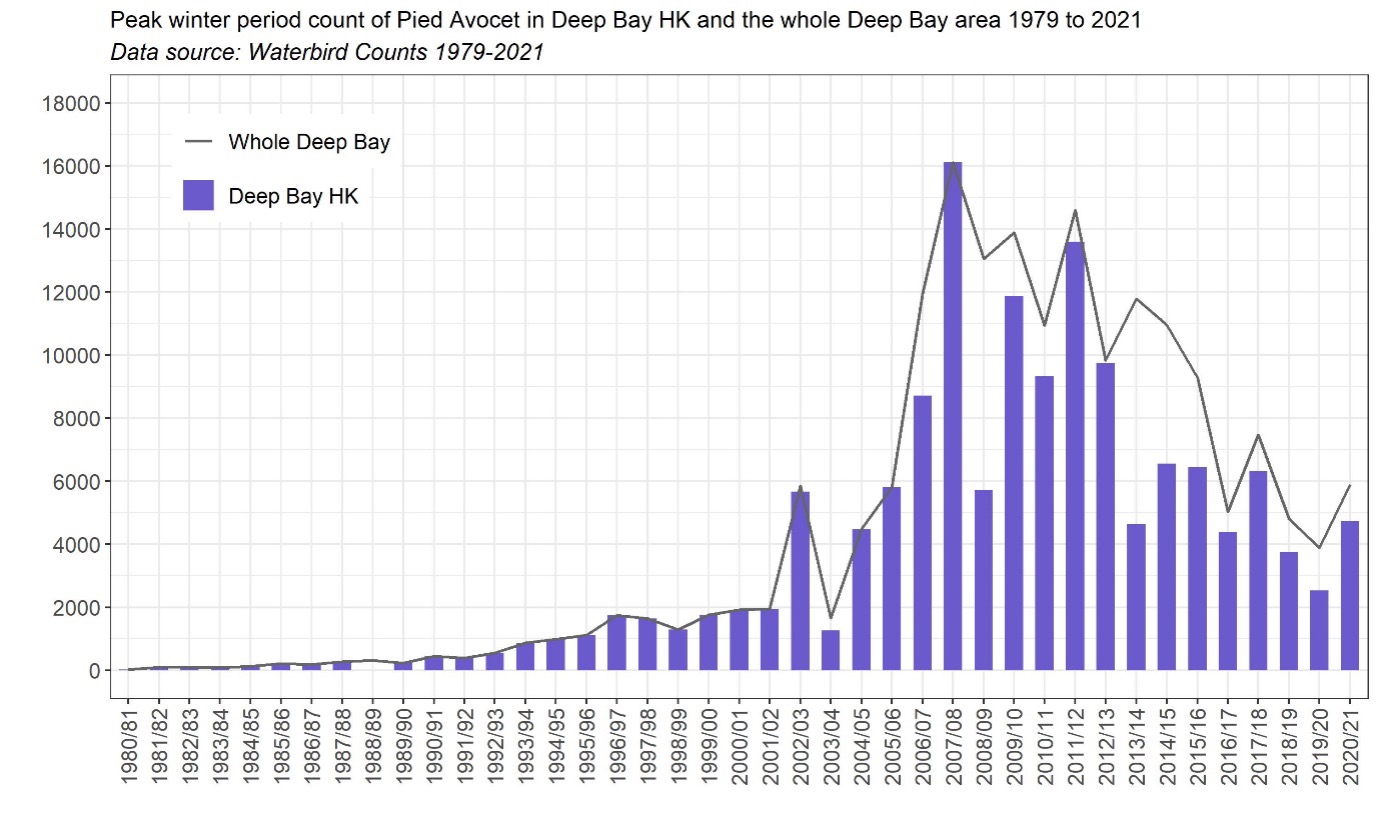Pied Avocet Recurvirostra avosetta 反嘴鷸
Category I. Abundant winter visitor to Deep Bay area.
IDENTIFICATION

Jan. 2006, John and Jemi Holmes.
42-45 cm. Appearance unique in the region due to black and white plumage pattern, long, fine-tipped, upturned bill and pale bluish-grey legs. Male has longer and slightly straighter bill; female head pattern sometimes less clear. Juvenile markings dull brown, white areas sullied brownish.
VOCALISATIONS
Limited range of sounds that appear to function both as call and alarm.
DISTRIBUTION & HABITAT PREFERENCE
The great majority of records are from the Deep Bay area, mainly the intertidal areas and adjacent roosting areas of Mai Po NR. As numbers increased over the years birds occurred in more widespread areas of the Deep Bay hinterland, including commercial fish pond areas as far as Hoo Hok Wai and along river channels as far as Kam Tin. First recorded at Long Valley in 2006, Pied Avocet has been regular there in winter since 2010/11, with the highest count being 38 on 7 December 2012.
Away from the northwest New Territories there are relatively few records: at Chek Lap Kok airport island (including two birds during 12-30 December 2015), Kai Tak Runway Park, Starling Inlet/Luk Keng (peak count 48 on 7 December 2012, the highest count away from the northwest New Territories), two records of singles at Shuen Wan and Ting Kok and one at Mui Wo.
OCCURRENCE
Abundant winter visitor. Figure 1 illustrates the pattern of occurrence as measured by monthly waterbird counts during the winter period and indicates that numbers are highest in February and remain relatively high into March.
Figure 2 indicates that winter 1992/93 saw the beginning of an increase in numbers that brought a quadrupling by the turn of the century. The increase continued and was even more rapid after 2002/03, reaching a peak of 16,123 on 13 January 2008. Since 2012/13, however, numbers have declined to less than 50% of that number. Based on winter waterbird counts in Deep Bay Sung et al. (2021) concluded that the wintering population increased from 1998 to 2017.
The increased abundance this century is also reflected in the more extended period of occurrence. Systematic shorebird counts since 1998 indicate that Pied Avocet is typically obvious from the third week of September to the middle of June, a longer period than stated in Carey et al. (2001) in which it was the first week of October to the second week of May. There is possibly an influx of migrants in the last half of March and first week of April. The numbers present in late spring are somewhat erratic. In particular, the years 2013-2016 saw rather high numbers present at this time. In 2014 up to 4,000 birds were recorded in the first half of April, with 2,585 still present on 2 May; approximately 2,500 birds also remained to mid-April 2013 and 2016, while 1,022 birds were counted on 29 May 2015. No more than double-figure counts have been made from 19 June to 18 September, though birds have remained during the summer in most years since 2014.
Pied Avocet was not recorded in Hong Kong until 20 February 1957 (Walker 1958). Thereafter, the highest count per winter was no more than 14 until winter 1971/72 when 30 were present; three-figure counts began in winter 1984/85 and four-figure counts in winter 1993/94.
BEHAVIOUR, FORAGING & DIET
Highly gregarious, especially in intertidal areas where large flocks form. Also associates with groups of Black-winged Stilt when at fresh or brackish water wetlands (especially commercial fish ponds). Most birds forage and roost in intertidal areas, and it is uncommon for large flocks to roost on Mai Po NR.
Typical foraging behaviour is to scythe bill through shallow water using the sense of touch to locate prey.
RANGE & SYSTEMATICS
Monotypic. Migratory populations breed in scattered areas of western Europe east through the Black and Caspian Sea areas to Kazakhstan, southern Siberia, Mongolia and China; these birds winter in southern Europe, north and central Africa and locally in the Middle East and southwest Asia, and more widely in south China. Resident or nomadic in east and south Africa (Pierce et al. 2020). In China it breeds in the northeast and northwest, is a migrant through much of the rest of the country and winters from the middle and lower reaches of the Yangtze floodplain south to the coast, including Hainan and Taiwan (Liu and Chen 2020).
CONSERVATION STATUS
IUCN: Least Concern. Population trend unknown.
Figure 1.

Figure 2.

Liu, Y. and Chen, Y. H. (eds) (2020). The CNG Field Guide to the Birds of China (in Chinese). Hunan Science and Technology Publication House, Changsha.
Pierce, R. J., G. M. Kirwan, and P. F. D. Boesman (2020). Pied Avocet (Recurvirostra avosetta), version 1.0. In Birds of the World (J. del Hoyo, A. Elliott, J. Sargatal, D. A. Christie, and E. de Juana, Editors). Cornell Lab of Ornithology, Ithaca, NY, USA. https://doi.org/10.2173/bow.pieavo1.01
Sung, Y. H., C. C. Pang, T. C. H. Li, P. P. Y. Wong and Y. Y. Yu (2021). Ecological Correlates of 20-Year Population Trends of Wintering Waterbirds in Deep Bay, South China. Frontiers in Ecology and Evolution. Published 20 April 2021 doi: 10.3389/fevo.2021.658084
Walker, F. J. (1958). Field observations on birds in the Colony of Hong Kong. Hong Kong Bird Watching Society, Hong Kong (duplicated).

